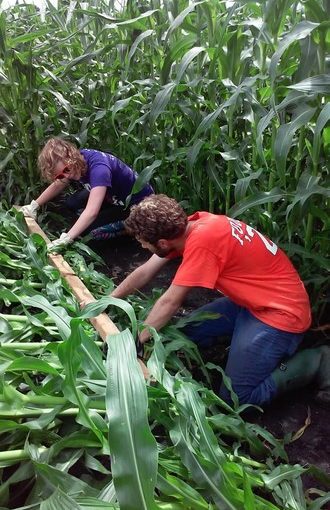Jun 3, 2021Growing sweet corn at higher densities doesn’t increase root lodging risk
Sweet corn growers and processors could be bringing in more profits by exploiting natural density tolerance traits in certain hybrids.
That’s according to 2019 research from USDA Agricultural Research Service (ARS) and University of Illinois scientists.
But since root systems get smaller as plant density goes up, some in the industry are concerned about the risk of root lodging with greater sweet corn density. New research says those concerns are unjustified.


“Root lodging can certainly be a problem for sweet corn, but not because of plant density. What really matters is the specific hybrid and the environment, those major rainfall and wind events that set up conditions for root structural failure,” said Marty Williams, USDA-ARS ecologist, affiliate professor in the Department of Crop Sciences at Illinois, and author on a new study in Crop Science.
Williams and his co-authors used multiple approaches to understand the effects of planting density on root lodging in sweet corn. First, they planted sweet corn hybrid DMC 21-84 – a density-tolerant type that happens to be one of the most widely grown commercial hybrids – at five densities in experimental plots on U of I farms. When plants were at the tasseling stage, the researchers simulated a natural lodging event by flooding the field and knocking the corn over with a two-by-four.
“We mimicked a root lodging event with pure brute force,” Williams said.
When corn is flattened in the process of root lodging, it can, depending on the growth stage, right itself through the plant’s natural inclination to grow toward the light. As corn grows back upward from its repose, the base of the stem often carries a curved reminder of its lodging legacy, known as a gooseneck.
Williams and his team found most plants recovered to a near vertical position, albeit with a bit of goose-necking, within a few days of the artificial lodging event. They also measured yield metrics, and found no statistical difference in sweet corn yield between lodged and non-lodged plants.
But a two-by-four and brute force can’t replace nature.
“Testing a crop’s root lodging potential experimentally is inherently difficult. Simply put, a natural root lodging event may not happen in any given field experiment. As such, phenotyping crops for root lodging often employs the use of artificially created lodging events, like the ones we created,” Williams said. “While artificially created root lodging events are helpful, used alone they often fail to capture a broad range of environments in which the crop is grown.”
That’s why the research team leveraged data from on-farm sweet corn trials across Illinois, Minnesota and Wisconsin. Between 2013 and 2017, the team evaluated economic optimum density for DMC 21-84 and 10 other hybrids under real-world farm management. And during that time, natural lodging events happened to occur in six of the 30 fields.
“We happened to take notes on lodging severity. It wasn’t our specific focus at the time, but we figured, let’s go ahead and score this and maybe we’ll use it later. Turns out it was great that we collected root lodging data, because we were able to use it for this study,” Williams said.
Those fortuitous notes showed that when sweet corn density increased from the current standard to the economic optimum density, typically a few thousand more plants per acre, there was absolutely no difference in the severity of lodging.
“What excited me about this work is that we combined an experiment where we created lodging artificially and looked at the response, and then we also tapped into this network of naturally occurring events. Together, they told a pretty convincing story,” Williams said. “Simply put, root lodging potential should not keep us from using plant density tolerant hybrids and growing them at their correct density. I mean, there’s always the possibility that root lodging could occur, but it’s not going to be due to planting a few more plants.”
The article, “Economic optimum plant density of sweet corn does not increase root lodging incidence,” is published in Crop Science [DOI: 10.1002/csc2.20546]. Co-authors include Williams, Nicholas Hausman, Daljeet Dhaliwal, and Martin Bohn, Department of Crop Sciences, and Tony Grift, Department of Agricultural and Biological Engineering. Both departments are in the College of Agricultural, Consumer and Environmental Sciences at the University of Illinois. Williams’ primary affiliation is with the USDA-ARS Global Change and Photosynthesis Research Unit in Urbana, Illinois.
– Lauren Quinn, University of Illinois














